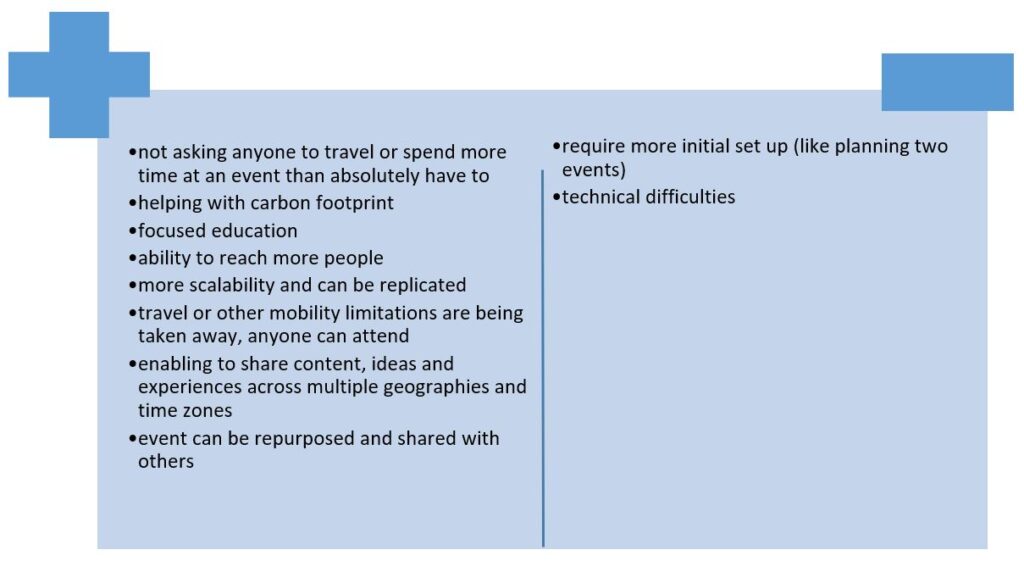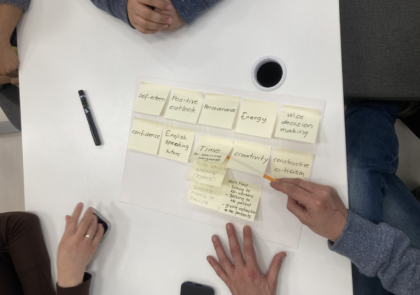
The COVID-19 pandemic raised an interesting question on how online or hybrid events would evolve? As the pandemic progressed and people were stuck at their homes due to restrictions to limit the spread of the virus, the world online revealed its possibilities. The event industry suffered enormously of the cancellations of mass events and suddenly, event organizers had no more work. Companies started to move their procedures online and the same happened to events. With limitations, possibilities for different kind of inclusiveness came as there was no other option to meet, more people found alternatives.
Authors: Linda Nilsson & Brett Fifield
Events are engagement
In Poetics (Myers, 2019), Aristotle wrote: “A whole story is what has a beginning and middle and end.” In the event world, the terms of pre-event, during and post-event are being used. First the event needs to be defined. Event on its own is a fixed period group activity, with multiple stakeholders, which are designed to produce a service, resulting in product. Event is temporary. It has a defined beginning and an end time and for that reason a defined scope and resources.
An event is a carefully crafted experience delivered to make an impact on the person in attendance. Regardless of the type, event planning requires people who can design the event, manage human and material resources, plan strategically, conceptualize the logistics of event, manage time effectively, and forecast and budget finances. (Greenwell et al. 2019). Events have a big role not only in networking, learning, sharing, and experiencing but they also impact the economy. International events are growing in popularity and are on the rise — due to globalization and the dramatic growth or the experience, cultural and creative industries, and the rapid increase in linkages between people, places, communities, countries, and markets. (Ferdinand & Kitchin 2017, 11)
Path of the modern event industry has not always been smooth, and it has faced many challenges in its short history. These include terrorist attacks, SARS, major upheaval in the global insurance industry which has led to the industry having to adopt strategies for man-aging the risks of events. (Allen 2012, 10)
According to a study in 2012 by Fryatt et al. (2012a) remote attendance has been positioned negatively compared to face-to-face attendance, only 15% had said that it is a positive thing. Meeting professionals employ hybrid event technologies to share content, ideas, and experiences with attendees across multiple geographies and time zones, but many still oppose the medium, citing technology failures and potential cannibalization to face-to-face events. The data revealed there to be anxieties surrounding the degeneration of in-person events. Virtual meetings have made it possible for potential clients across all business units to get a consistent experience in a systematic way.
Limitations Turned into Inclusiveness
Fryatt et al. (2012a) as well as Morell (2010) found that the hybrid meeting will be able to extend the life of a meeting. Hybrid events can also give you an opportunity to add value by reaching more delegates (face-to-face plus virtual), providing new content delivery and communication options. You will be able to connect multiple events occurring concurrently or at different times or locations. Your event content will not be just one off event as you will be able to extend the reach of your message by repurposing part of your event content and make it possible for everyone to take part, even if they are not able to travel to the location, or would have other reasons why you would not make it. As we have seen through the COVID-19 pandemic, hybrid and virtual events have been able to take away limitations such as travel restrictions or country borders. People around the world have been able to attend conferences and events that they might not have done in the past or had the opportunity to do so. This new situation has forced us to use new technologies which in turn have enabled us to be able to share content, ideas and experiences across multiple geographies and time zones.
Engaging Your Participants
Event Canvas model (Frissen et al., 2016) gives you a guide on how to include various stakeholders into creating a successful and engaging event through empathy maps. As the design of these virtual events is crucial when you want to engage audiences from around the globe or virtually in general. When you think about all your stakeholders from their perspectives and what their needs are, you can design an event that will be successful and catering to your stakeholders need and expectations.

Figure 1: Possibilities and limitations on virtual/hybrid events (Nilsson 2020)
What might work for in-person audience, might not be working for the remote audience. For remote audiences it is important to create a sense of belonging, taking their questions and providing them with exclusive content. Some are also using virtual emcees and facilitators. There is a need for training the speakers for hybrid events as they need to be even more engaging than normal. (Cook & Shepherdly 2016)
Hybrid events give you an opportunity to add value by being able to reach more people (face-to-face plus virtual) and for that reason you need to be able to cater to both these audiences. As hybrid events require new means of content delivery and engagement, you must be able to recognize the diverse audiences and their needs. Additional challenges come as not all content from live events are good for remote, so it is important to adapt the content from face-to-face to remote by offering shorter sessions as the attention span is shorter. It is said that the most effective hybrids are like TV shows, which then give new tools to design and deliver content such as man-on-the-street interviews, talk shows and news desk formats. (Fryatt et al. 2012b). Sporting events can be used as an example, as they already must take into consideration various attendees and types from the onsite to offsite audiences. They have also understood importance of the engagement within these events. Sports are widely marketed as entertainment, and many spectators attend them for reasons beyond just watching the players on the field. Major sporting events also include fancy halftime shows, on-field contests, and promotional giveaways. Relaxation and pleasure are common motivational factors for many tourists and some fans use sport tourism to escape from under stimulation and boredom from overstimulation and stress. Sport tourism has been described using a theatrical analogy suggesting that players represent the actors, sport spectators are the audience members, and the stadium or arena is the theater. (Greenwell et al. 2019)
Planning a hybrid event is almost like planning two events
As per Fryatt et al. (2012c) and results of the research by Nilsson (2020), planning a hybrid event is almost like planning two events due to the nature of them. The event content will not just be a one off event, but can now be repurposed and shared with others, and no matter what kind of limitations there would be for travel, you would be able to connect with these people. For example, contrary to previous opinions regarding online events and how they would not be participated as easily as tangible events, the pandemic changed the current consensus to pro-online. Hybrid events indeed, will take advantage of limitations and enable more possibilities for inclusiveness – let it be in person or online.
References
Allen, J. 2012. Selected Chapters from Allen: Festival & Special Event Management. Fifth ed. Mississauga (Ontario): John Wiley & Sons Canada, Ltd.
Cook, P. & Shepherdly, M. 2016. Remotely Engaging: How to reach new audiences by breaking out of the conference center. 1 ed. s.l.: Amazon Fullfilment.
Ferdinand, N. & Kitchin, P.J. 2017. Events Management -An International Approach. Second ed. London: SAGE Publications Ltd., 1 Olivers Yard, 55 City Road, London, EC1Y1SP
Frissen, R., Janssen, R. & Luijer, D., 2016. Event Design Handbook. 2nd printing ed. Amsterdam: BIS publishing.
Fryatt, J. et al. 2012a. How to Guide: Hybrid Meetings, s.l.: Meeting Professionals International.
Fryatt, J. et al. 2012b. How to Guide: The Strategic Value of Virtual Meetings and Events, 2012: Meeting Professionals International.
Fryatt, J. et al. 2012c. Hybrid Meetings and Events, s.l.: MPI Foundation.
Greenwell, C. T., Danzey-Bussell, L. A. & Shonk, D. 2019. Managing Sport Events. s.l.: Human Kinetics, Business & Economics.
Morell, K. 2010. How to use hybrid meetings to drive attendee engagement, s.l.: Meetings Today.
Myers, S. 2019. Beginning. Middle. End. s.l.:Medium.
Nilsson, L. 2020. Hybrid Events: Breaking the Borders. Master´s thesis. LAB University of Applied Sciences, Faculty of Business and Hospitality Management. [Cited 16.6.2020]. Available at: http://urn.fi/URN:NBN:fi:amk-2020061618890
Authors
Linda Nilsson is studying in the International Business Development program at LAB University of Applied Sciences.
Brett Fifield is a Principal Lecturer in International Business at LAB University of Applied Sciences.
Illustration: https://pxhere.com/fi/photo/1575129 (CC0)
Published 25.6.2020
Reference to this article
Nilsson, L. & Fifield, B. 2020. How hybrid events can be used to transfer limitations into inclusiveness. LAB Pro. [Cited and date of citation]. Available at: https://www.labopen.fi/lab-pro/how-hybrid-events-can-be-used-to-transfer-limitations-into-inclusiveness/






